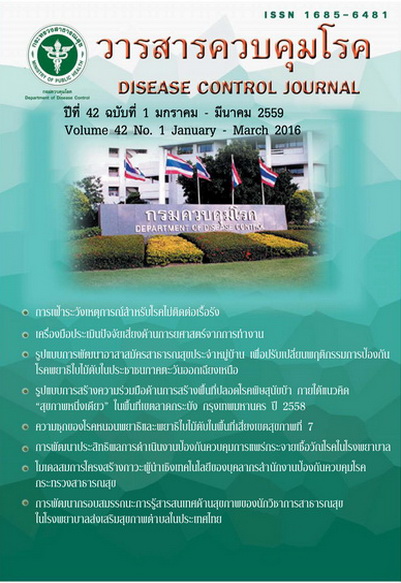The model of Village Health Volunteers development for behavior modification for liver fluke prevention of local people in Northeast region
DOI:
https://doi.org/10.14456/dcj.2016.29Keywords:
Village Health Volunteer, behavior modification, liver flukeAbstract
The objectives of this research were to develop the model of Village Health Volunteers (VHVs) de¬velopment for behavior modification for liver fluke prevention of local people in Northeast region. The study was research and development design. The research was divided into 2 phases. The first phase aimed to establish and examine the developed model by considering the model of VHVs development through a sem¬inar of 12 experts. The second phase aimed to test the model of VHVs development, selected by simple random sampling. The sample consisted of 570 VHVs and 1,143 people in three provinces of Northeast region, TaoNgoi District Sakonnakhon Province, Selaphum District Roiet Province and Thepsatid District Chaiyaphum Province. Data were collected from the questionnaire and analyzed by using inferential statistics including t-test. The results of this research showed that: 1. The model of VHVs potential development for behavior modification for liver fluke prevention of local people in Northeast region consisted of three main measures as follows: (1) service-based process (2) home-based process and (3) community-based process 2. The results of testing the model of VHVs development for behavior modification for liver fluke prevention of local people in Northeast region showed that: (1) service-based process statistically significantly of VHVs’ perceived barriers, self-efficacy and behavior for liver fluke prevention, and perceived ability of learning management through VHVs home visiting. The sample’s post-test score was higher than pre-test score at a .001 statistical significance level. (2) home-based process statistically significantly of perceived barriers, self-efficacy and behavior for liver fluke prevention. The sample’s post-test score was higher than pre-test score at a .001 statistical significance level and (3) community-based process found that the area that developed innovations for live fluke prevention gained 26.19% response rate, which was pass the standard criteria level.
Downloads
References
2. สถาบันมะเร็งแห่งชาติ กรมการแพทย์ กระทรวงสาธารณสุข. Cancer in Thailand 2007-2009 [อินเทอร์เน็ต]. [สืบค้นเมื่อ 20 มี.ค. 2558]. แหล่งข้อมูล: http://www.nci.go.th/th/cancer_record/cancer_rec1.html
3. Harinasuta T, Riganti M, Bunnag D. Opisthor¬chis viverrini infection: pathogenesis and clinical features. Arzneimittelforschung 1984;34:1167-9.
4. IARC. Infection with liver flukes (Opisthorchis viverrini, Opisthorchis felineus and Clonorchis sinensis). IARC Monogr Eval Carcinog Risks Hum 1994;61:121-75.
5. สำนักโรคติดต่อทั่วไป กรมควบคุมโรค กระทรวงสาธารณสุข. รายงานประจำปี 2554 สำนักโรคติดต่อทั่วไป กรมควบคุมโรค กระทรวงสาธารณสุข [อินเทอร์เน็ต]. [สืบค้นเมื่อ
10 มิ.ย. 2558]. แหล่ง ข้อมูล: http://thaigcd.ddc.moph.go.th/uploads/ file/Annual-A3.pdf
6. กรัณฑรัตน์ บุญช่วยธนาสิทธิ์, นิรันตา ไชยพาน, จักรกฤษณ์ พลราชม, มาสริน ศุกลปักษ์, นารีรมย์ รัตนสัมฤทธิ์. การพัฒนารูปแบบการปรับเปลี่ยน พฤติกรรมเพื่อการป้องกันโรคพยาธิใบไม้ตับใน ชุมชนภาคตะวันออกเฉียงเหนือ. กรุงเทพมหานคร: บริษัท แดเน็กซ์ อินเตอร์คอร์ปอเรชั่น จำกัด; 2557.
7. Krejcie R. V., Morgan D. W. Determining sample size for research activities. Educational and Psy¬chological Measurement 1970;30:607-10.
8. Keeves P.J. Educational research, method, metho-dology and measurement: An International hand¬book. Oxford: Programon Press; 1988.
9. บุญชม ศรีสะอาด. การวิจัยเบื้องต้น. พิมพ์ครั้งที่ 2. กรุงเทพมหานคร: วิริยสาสน์; 2545.
10. Becker MH, Maiman LA. The health belief model: Origins and correlation in psychological theory. Health Education Monography 1975; 2:336-85.
11. Bandura A. Self-efficacy: The exercise of con¬trol. New York: W.H. Freeman and Company; 1977.
Downloads
Published
How to Cite
Issue
Section
License
Articles published in the Disease Control Journal are considered as academic work, research or analysis of the personal opinion of the authors, not the opinion of the Thailand Department of Disease Control or editorial team. The authors must be responsible for their articles.






